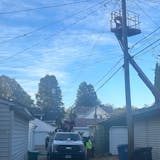In a high-stakes hearing, Minnesota appellate judges had sharp questions Tuesday for the Minnesota Public Utilities Commission (PUC) and Enbridge about the ultimate need for the company's new oil pipeline across northern Minnesota.
The Minnesota Department of Commerce, along with several pipeline opponents, have challenged Enbridge's long-term oil demand forecast, which the PUC accepted when it approved the company's controversial new Line 3.
While the $3 billion-plus pipeline is half-built, the Minnesota Court of Appeals could freeze work if it rejects Enbridge's oil demand forecast.
A key issue before the court: Is the forecast simply a reflection of Canadian oil producers' supply projections? "It seems to take the approach of 'If we build it, they will come,' " Judge Peter M. Reyes Jr. said Tuesday during questioning.
A three-judge panel of Reyes, Lucinda Jesson and Michael Kirk also heard arguments Tuesday on other challenges to the PUC's Line 3 approval, including whether the project's environmental review adequately considered effects of an oil spill in the Lake Superior watershed.
The court has 90 days to make a decision on the appeals.
The Commerce Department and pipeline foes have long argued that oil demand — including from Canada — will fall as the world migrates from fossil fuel, including by adopting electric vehicles. Enbridge's forecast didn't properly account for that transition, they say.
Enbridge has long argued that its corridor of pipelines across northern Minnesota is so full that it can't meet oil shippers' demands — a condition that will continue for a long time. The PUC agreed, as it did with Enbridge's contention that new Line 3 is needed for safety.


